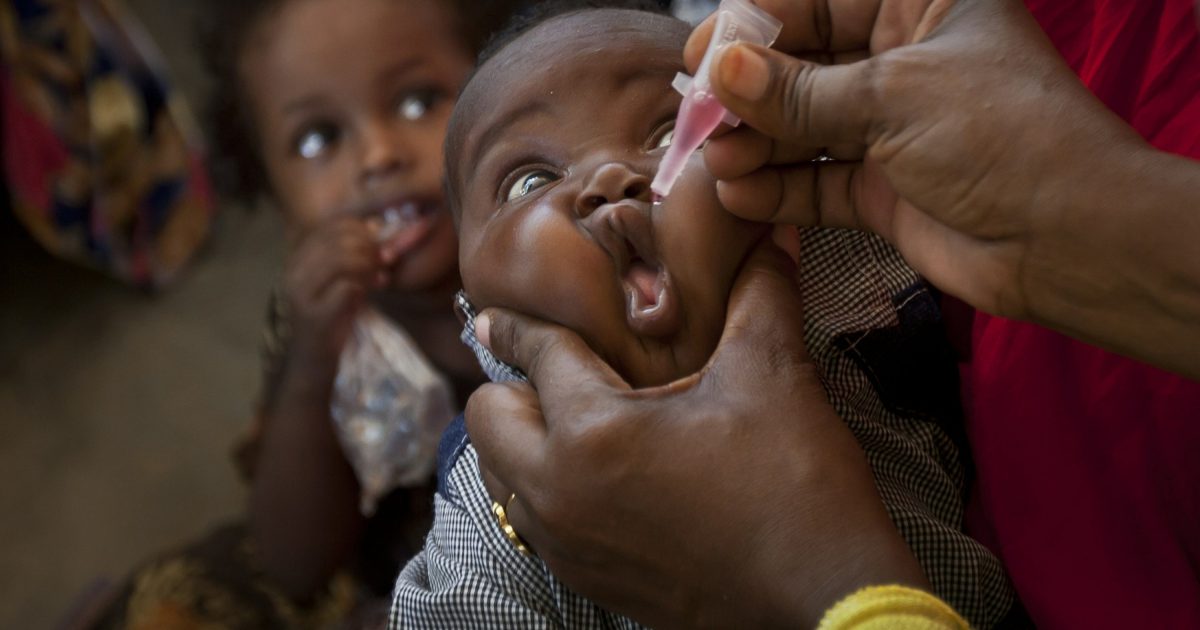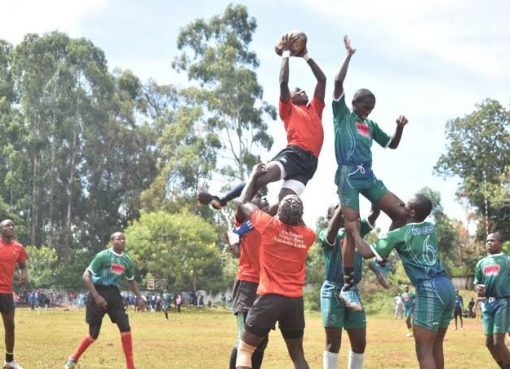Kenya has concluded a five days polio vaccination campaign that targeted 13 counties during a door to door exercise.
The exercise which kicked off in May 22nd was undertaken in selected counties including Kiambu, Mandera, Isiolo, Wajir, Garissa, Lamu, Tana River, Kilifi, Mombasa, Kitui, Machakos, Kajiado, and Nairobi which were identified as high risk areas
The campaign is targeting over 3.4 million children with the second phase of vaccination scheduled for June 19th to 23rd 2021
And in Kiambu county at least 21,134 children aged below 5 years recieved the monovalent oral polio vaccine (mOPV) during the first phase.

Speaking during the launch of the exercise on 22nd May 2021 at the Kiambu Level five hospital Professor Rosemary Sang Ministry of Health (MoH) representative and a Research Scientist at KEMRI advised the public to be more vigilant in the fight against polio.
“With the help of our Community Health Volunteers (CVH`s) progress has been made to ensure that the disease is detected in the community” said Prof. Sang
“As much as we are polio-free, other neighboring countries with health care systems that are not stable the disease is able to reach us and we should not let our guard down” added Prof. Sang.
Dr. June Muthiora Kiambu sub-county Medical Officer of Health (MoH) noted that they are targeting 21,134 children in 51,000 households which are over 95% of the population.
“Our goal is that each child under 5 years will be immunized to boost their immunity in addition to the Kenya Expanded Programme on Immunization (KEPI) vaccines which provide immunization against tuberculosis, diphtheria, whooping cough, tetanus, measles, and polio” said Dr. Muthiora
She further observed that the program comprised 33 mobile teams that would move around markets and bus stops and 18 static teams and also the CVH`s who have been on the ground preparing caregivers for the past three days.
Dr. Charles Muitherero, the World Health Organization (WHO) Representative assured the public that they are managing surveillance and epidemic response to prevent the spread of the disease.
“There are ongoing activities to detect the disease and act accordingly. The question of why children under five years have to undergo the routine vaccinations has come up severally on this forum and I would like to emphasize that it is for the sole purpose of boosting the immunity and ensuring the protection of the child” said Dr. Muitherero,
He further cautioned that it is our individual responsibility to look out for ourselves and look out for our neighbors as well and advise them.
The Ministry of Health (MoH) has increased monitoring efforts to detect any poliovirus circulation and is undertaking polio vaccination campaigns to help improve child immunity against the disease.
The World Health Organization has declared the polio vaccine to be safe and reliable. Vaccinators and monitors, as well as social mobilizers, church leaders, polio champions, and others, have been educated and deployed to ensure widespread community involvement.

County Executive Committee (CEC) Health Dr. Joseph Murega spoke on the importance of proper sanitation and personal hygiene when it comes to battling Polio and Covid-19.
“Polio dates back to the pre-historic times and due to the influx of movement of people across the borders the disease spread. It paralyzed and killed during the pandemic period. It is transmitted through food and water and it is preventable” said Dr. Murega
“CVH`s have played a big role in sensitizing the community and also helped in mobilization. In order to make this campaign a success, we have to go the community and find children who have been affected by polio and also locate those who missed out on the immunization during the Covid-19 restriction of movement and ensure they get immunized. Polio is preventable but not curable and we should join hands and prevent it from spreading” added Dr. Murega
Kenya has been free of any wild poliovirus (WPV) circulation since 2014. However, we continue to be at higher risk of polio due to low immunization coverage magnified with population movement. Polio is highly infectious, debilitating disease which affects children and causes permanent paralysis. Polio is not curable, and can only be prevented by vaccination.
Mrs. Sarah Nyoro who also graced the event said that the disease affects the whole family and it is very expensive in terms of therapy and medication
“Even as we purpose to fight Polio, we should continue observing the Covid-19 protocols. All parents should get their children immunized even if they had previously done so because the virus has mutated from the other variant” said Mrs. Nyoro
“This fight should be close to all our hearts and we are working towards eradicating polio completely by sensitizing people at home and tearing down the cultural and religious inhibitions against vaccination”
Families and communities must ensure their children are vaccinated both during polio campaigns and through routine immunization.
According to Health Cabinet Secretary Mutahi Kagwe last week during the polio meeting hosted for stakeholders and media at a Nairobi hotel, the five-day drive has been necessitated by reports of poliovirus cases that were detected earlier this year in February after surveillance teams confirmed six cases in Garissa and Mombasa respectively.
“So far, three cases have been identified from children and three from sewage samples. All the children were new entrants into Garissa County from Somalia. One of the sewage samples was collected from the Bouralgy site in Garissa town,” said CS Kagwe.
“All samples detected to date are genetically linked to the cVDPV2 sequence for viruses isolated in Somalia” he added.
While acknowledging the threats diseases pose to humankind with the COVID-19 pandemic a testament to this danger, Kagwe noted that children aged below 5 years are particularly vulnerable to diseases with their immunity not yet fully developed to fight most infections. “Polio, an infectious disease caused by the poliovirus, remains one of the most serious diseases,” warned Kagwe.
“Not only does it cause paralysis and permanent disability, but it can also kill as it affects the muscles that aid in breathing. For example, during the 2013 polio outbreak in Garissa County, 14 people were paralyzed by the disease. Another 2 died following complications arising from the disease. It is worth noting that no cases of children with polio paralysis have yet been detected in the 13 counties, but we fear that, without swift action, it will only be a matter of time before this happens.” noted the CS.
Kagwe said the Ministry has intensified surveillance in all regions with more emphasis on frontier counties along the Kenya-Somalia and Kenya-Ethiopia borders due to cross border transmission of the poliovirus.
“This is besides the scaling up of routine immunization activities across the country. To actualize these efforts, the Ministry of Health has activated the National Public Health Emergency Operations Center. Further, the Ministry is working in coordination with critical partners in this response,” he said.
Additionally, the ministry has since intensified surveillance across all regions with more emphasis on frontier counties located along the Kenya-Somalia and Kenya-Ethiopia common borders. This is besides the scaling up of routine immunization activities across the country.
To actualize these efforts, the Ministry of Health has activated the National Public Health Emergency Operations Center. Further, the Ministry of Health is working in coordination with critical partners in this response.
Kenya experienced two wild poliovirus outbreaks in 2006 in the then Garissa District (now a County) with dates of onset of paralysis on 17 September and 13 November respectively. In February 2009, a wild poliovirus importation from South Sudan resulted in 19 cases in Turkana County.
The July 2011 WPV outbreak detected in Kamagambo, Rongo district of Kenya was an importation from Uganda and was genetically linked to the 2009 outbreak in Turkana, Kenya and the 2010 outbreak in Bugiri districts of Uganda.
In July 2012, the Dadaab refugee camps recorded two cases of circulating vaccine-derived poliovirus. Response to each outbreak was according to WHO guidelines which required immediate outbreak investigation, vaccination response around the cases, strengthening of AFP surveillance and enhancing routine immunization.
Between May and July 2013, 14 WPV 1 cases occurred along the axis of Dadaab, Fafi and Hulugho sub-Counties of Garissa County in Kenya, all linked to Somalia.
Since 1988, enormous progress has been made in polio eradication around the world. Kenya has witnessed a polio outbreak along the Somalia-Kenya border for the third time in a decade. The areas affected were in Garissa County, which had seen previous outbreaks in 2006 and 2012.
Though the World Health Organization (WHO) had certified the Africa Region polio-free in 2020, the ongoing COVID-19 pandemic and weaknesses in routine immunization in our neighboring countries have led to a resurgence of polio outbreaks.
During the last polio campaign, conducted in November 2019 targeting 11 high-risk counties, 2, 724,956 children against a target of 2,636,037 were vaccinated, a success rate of 103%.
The solution has been the same for all polio outbreaks to immunize every child during every campaign and complete the full routine immunization schedule to improve all child immunity in this community to stop poliovirus circulation.
By Lydia Shiloya




